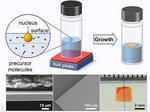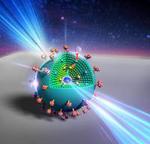Other

“In the race to replace silicon in low-cost solar cells, semiconductors known as metal halide perovskites are favored because they can be solution-processed into thin films with excellent photovoltaic efficiency. A collaboration between KAUST and Oxford University researchers has now …

“How we use and generate electricity has changed dramatically over the past century yet the basic components that control its flow remain remarkably similar. Researchers at KAUST have now developed a novel type of component that could improve the performance …

“Introducing asymmetry across the two sides of atomically thin materials brings new opportunities in semiconductors. Semiconductor materials called dichalcogenides may gain broader properties when asymmetry is introduced across the plane of sheets of bonded atoms. KAUST researchers have created a …

“A crystalline material that changes shape in response to light could form the heart of novel light-activated devices. Perovskite crystals have received a lot of attention for their efficiency at converting sunlight into electricity, but new work by scientists at …

“Most electronic devices currently contain silicon-based chips. Other semiconducting materials show potential, but need further research to become commercially viable. Researchers at KAUST have thoroughly analyzed one such material—metal-nitride nanowires—bringing them a step closer to being useful. When …

“Swirling objects known as magnetic vortices and skyrmions can be miniaturized without sacrificing mobility, a KAUST-led international research team has found. These findings are relevant for future “race-track” memory technologies that feature massive densities of moveable magnetic bits. In …

“Engineered nanometer- and micrometer-scale structures have a vast array of uses in electronics, sensors and biomedical applications. Because these are difficult to fabricate, KAUST researchers are trying a bottom-up philosophy, which harnesses the natural forces between atoms and molecules such …

“Searching for recurring patterns in network systems has become a fundamental part of research and discovery in fields as diverse as biology and social media. KAUST researchers have developed a pattern or graph-mining framework that promises to significantly speed up …

“Current underwater exploration and monitoring of oceanic resources is both expensive and challenging. It requires human divers who can only explore underwater environments during short periods of time and who can only safely go down to certain depths. Underwater vehicles …

“A team of researchers at King Abdulla University of Science and Technology in Saudi Arabia has made the blackest material ever created by human beings. As they note in their paper published in Nature Nanotechnology, the idea for the material …
